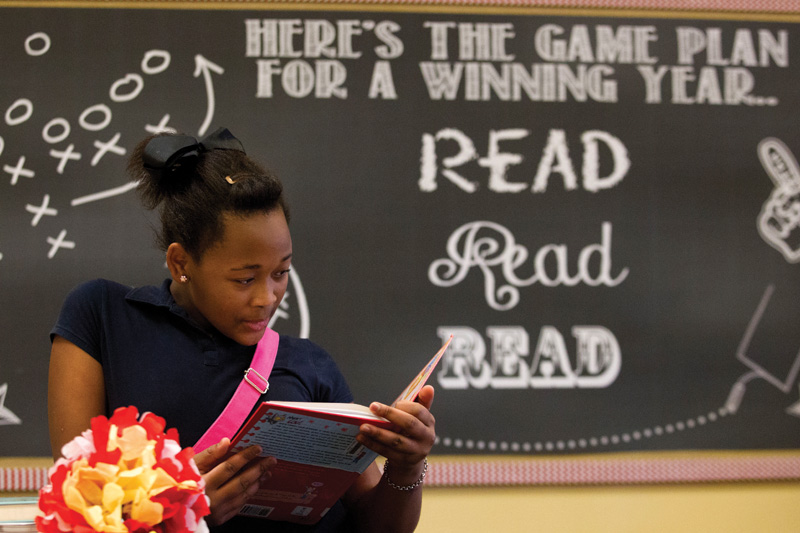
Texas’ Disappearing School Librarians

A version of this story ran in the December 2013 issue.
Above: Meisha Washington reads a book in the newly reopened library at Houston’s Hogg Middle School. The library had closed due to state budget cuts.
There once was a time in Texas when adding more students and building new schools also meant hiring more school librarians. What magical, idyllic times those must have been, way back in 2010.
In the past three years, Texas has been hemorrhaging librarians. Even as the number of students in Texas public schools exceeds five million, the number of certified librarians in schools has dropped by 500, down to 4,640. Texas has about as many librarians today as it did a decade ago, when schools had 600,000 fewer students.
Even after absorbing $5.4 billion in funding cuts from the 2011 Legislature—damage only partially remedied this year—Texas schools have shed 3 percent of their counselors, 2 percent of their teachers and 1 percent of their nurses. But they’ve cut 9 percent of their librarians. (All while the student body grew by 3 percent.) Forced to skimp by the Legislature, many administrators went skimping in the library.
In early October, the Houston Chronicle told the story of Mary Burgert, a middle-school librarian laid off mid-year because of budget cuts. Houston ISD is a particularly tough place for librarians. The state’s largest school district has just 97 certified librarians, down from 169 four years ago, according to the Chronicle. About 60 percent of the district’s schools, the Chronicle reported, are without a librarian this year. In dozens of schools, the library is simply closed.
You might be wondering, So what’s the big deal anyway? Is it really that hard to find a book? Can’t kids just figure out how to Google on their own?
Gloria Meraz with the Texas Library Association says a little respect for librarians, particularly in the Legislature, is long overdue.
“Like every group, we were cut in 2011, but we’ve seen the steady erosion of support for several years now,” she says. “The fact that there are districts that are opting to reduce the ranks of school librarians really puts Texas schoolchildren at a significant disadvantage.”
Meraz cites a 2011 Legislative Budget Board report that called librarians “critical to campus effectiveness and student achievement,” and a 2001 study that found higher standardized test scores in schools with libraries than in those without.
Even in the years before massive school budget cuts, library staffing wasn’t keeping pace with student growth. Many schools that report having a certified librarian on staff, Meraz says, share that librarian with another school. The state doesn’t set minimum standards for library staffing.
Some schools are turning away from physical library stacks in favor of tablet and laptop-borrowing media centers. Some charter schools skip the library altogether.
“I think it’s telling that there is no mandate for school librarians to be on each campus,” Meraz says. “So many people have a very outdated image of what a school library is.”
Beyond clerical shelf-sorting work, librarians are there to instill good research techniques and help distinguish between good and unreliable information—skills that become even more important when you get your facts off the Internet.
“It’s a common misconception. People think that, well, everything is online, so we don’t need librarians. Truly, nothing could be further from the truth,” Meraz says. “What we find is that people need even more help.”


